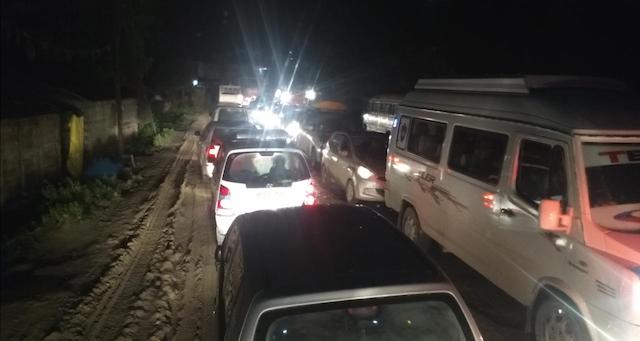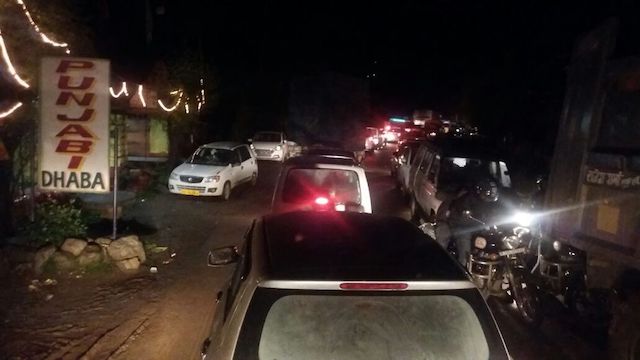Manali: This summer season has seen a massive increase in the number of tourist arrivals in Manali. This has mainly been so because a large number of tourists picked Manali over Jammu & Kashmir. While it was a handout for those associated with the tourism industry, the sudden rush has badly exposed the district administration about their capacity to handle the increased footfall.
A case in point is that to cover a mere 2 km road from Rangi to Manali Town took at times took over two hours of journey time. It was no better on the River Beas left bank road. Where tourists are able to reach Manali from Delhi in 20 hrs, this season it took on an average up to 4 hours to cover the 45 Km distance from Kullu to Manali.
With tourists flooding the town to get a respite from the summer heat, Manali this season even suffered an unprecedented day-long traffic jam on 8. may that took children two to three hours to reach home from their schools which was just 2 Kms away.
The year’s tourist season in Manali started with a nightmarish experience. Water scarcity, lack of parking spaces and traffic snarls has become a routine. Things get worse on weekends when people from nearby towns of Punjab and Haryana arrive and the footfall of 20,000 people on an average can double up on Saturdays and Sundays. There is simply no space to park and hardly any to even walk.
The ever going construction for upgrading Manali highway into a 4 lane between Kiratpur and Manali was another add on to the chaos as this stretch has become prone to land slides and frequent traffic grumbles. It is a common refrain that the drivers from the plains hardly have any idea of driving in the hills and try to overtake other vehicles frequently, thus breaking the line Overcrowding of people and vehicles has led to a delay in civic amenities. The result is that heaps of filth and public easing along the narrow roads has made it very difficult for the pedestrians to even stroll on the Manali Mall Road.
The tourist getaway has otherwise also a notorious reputation of its hoteliers fleecing people because the administration has failed to even get them to print tariff cards in all these years.
The air quality of this much sought after mountain resort was in the dumps as during peak tourist rush days the Respirable Suspended Particulate Matter (RSPM) increased by almost 40%. In Manali, the RSPM recorded at the weekends went up to 60.35 microgram per metric cube which is way above normal.
The situation is no better in the township as 90% of the hotels have no parking facility.
Things have come to such a pass that the Himachal Pradesh High Courts has been compelled to intervene on many occasions.
The Court has directed the Senior Superintendent of Police and District Magistrate of Manali to work out a plan to combat traffic snarls witnessed during the tourist season every year.
The court has also directed the state administration to come out with a long-term vision plan for regulating and managing traffic in Kullu, Manali, Rohtang Pass, Kasol and Manikaran.
‘Mere widening of roads or construction of new roads may not solve the issue per se. Traffic management includes many factors, like traffic control, which envisages measures of traffic flow, management of parking areas and removal of encroachments on roads, etc. It has to be understood that driving through a traffic congested area is tedious and the same adversely affects the health of one and all. There is not only waste of fuel, but it also pollutes the environment. Haphazard parking of vehicles, encroachments on roads, the absence of civic sense and lack of strict enforcement of traffic rules, all lead to traffic congestion’, is what the court order observed.
With the quality of life offered in Manali having deteriorated, Vikramjeet Singh, an old time resident says, “it is high the government intervenes and regulates tourism.”
Tourism has to be de-centralized and at certain places mass tourism has to be discouraged. Both our governments and tourists have misunderstood the concept of eco-tourism. A de-centralized development of tourism is about being sensitive to the environment where the common man living in far-flung areas that have an abundance of natural beauty is also a beneficiary. It does not mean construction of big concrete resorts in jungles.
Everything cannot be left to the courts to decide because courts can only give orders. It is the government and the administration that have to implement them in true spirit, added Vikarmjeet.
All this simply points towards the need for a rethink on the tourism policy of the state.
DSP Manali Shar Singh told the Hill Post that we have deployed extra police force to assist the tourist in town and to regulate the traffic.

Sanjay Dutta, an engineer by qualification but is a journalist by choice.
He has worked for the premier new agency Press Trust of India and leading English daily Indian Express.
With more than a decade of experience, he has been highlighting issues related to environment, tourism and other aspects affecting mountain ecology.
Sanjay Dutta lives in a village close to Manali in Kullu valley of Himachal.





